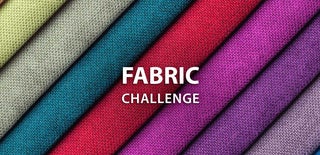Introduction: DIY Butterfly Toilet Mat
When I moved into my house, I wanted every room to have a theme, but couldn't really find a nice theme on the store shelves for the tranquil atmosphere that a bathroom should have. Over time I acquired a toilet seat with a butterfly design, then later decorated the wall tiles with butterfly stickers, at which point my run-off-the-mill toilet mat no longer fit the scene. The rare butterfly themed mats that were commercially available had poor composition and clipping, so I decided to just make the mat I had in mind.
Supplies
Materials:
- microfiber cloth, 50 x 60 cm
- non-slip mat or shelf lining mesh, 50 x 150 cm
- chenille wire, 1 piece of 20 cm
- sewing thread
- paper sheets, 4 x A4 or 2x A3
- sticky tape
Tools:
- pencil
- fabric markers
- paper scissors
- fabric scissors
- sewing machine
- an iron
- baking paper
Step 1: Prepare the Fabric
For a toilet mat we need a fabric that feels soft, can handle some moisture, and lends itself to painting on. Microfiber cloth has all these qualities, although it also comes with some peculiarities. Large microfiber cloths are commonly available in light blue, orange or yellow colours. If you can't find a large enough cloth, you can also consider sewing two smaller cloths together, seeing as butterflies are symmetrical.
Before we start, first wash the microfiber cloth at 40 degrees (Celcius), to remove oil residue and avoid shrinking afterwards. Do not use fabric softener when washing microfiber, and do not tumble-dry it.
Step 2: Design the Shape
Start by outlining the recess for the toilet bowl. It's easiest to trace and cut the outline from an old mat in two paper sheets, meeting in the middle.
If the recess is too wide, overlap the two cut halves until they fit the bowl better, then stick the sheets together with tape.
Tape two more paper sheets to the top of the cut sheets to form a paper mat.
Lure some butterflies in to model for you and sketch their outline (or, just look up some images). I went for a Blue Morpho butterfly because it's easiest to find blue cloth, my second choice would have been an orange Monarch butterfly. Don't worry about symmetry: You only need to get one side of the wings right.
Once you are satisfied with one side, fold your paper mat down the middle, cut the outline of the wings off, and fold it back out.
Finally, trace the paper shape onto the microfiber cloth with a marker.
Step 3: Cut and Sew
Cut out the contour of the butterfly with fabric scissors.
Sew the contour with a sewing machine using zigzag stitches of about 5mm. Do this twice if necessary to get a solid rim with the fabric neatly tucked in. You may use the same colour thread as the fabric, or use different threads matching the colour design of your butterfly.
The fabric may have become a bit curly after sewing, so steam iron it flat. If you have a regular iron, just make the cloth moist and then iron it. I used a plant sprayer.
Step 4: Draw a Butterfly
Use fabric markers to divide the butterfly in four quarters, and draw as you like. Butterfly wings look a bit like tree branches, or flower petals. I recommend using lines more than filled sections, as it takes a lot of ink to achieve solid coverage. I used two black markers, purple for the transition of body to wings, and blue as a subtler shade.
Let the ink dry for one hour, then cover it with baking paper and apply an iron on medium setting to heat-fix the ink to the fabric. If you set the iron too hot, the microfiber could melt, so it is wise to test on some of the left-over fabric cuttings first.
Step 5: Pad the Bottom
You now have an awesome looking butterfly, but it's still flimsy for a mat. To make it sturdier and less slippery, we will affix a plastic anti-slip mesh to the bottom. You can find these in stores with bathroom products, but they are also used as shelf liner, found in DIY and household stores.
Turn the butterfly bottom-up, cover it with the plastic mesh, and cut the mesh to shape, but a few millimeters smaller.
Cover the mesh with baking paper, and this time iron at a high setting and with some pressure, until the plastic mesh melts into the fabric. Iron the center first, as the plastic may shrink inward, then iron from the center outward. Make sure that the plastic merges good and well with the fabric at the edges of the mat.
Step 6: The Finishing Touches
The microfiber fabric probably looks flattened after all the ironing. To fluff it back up, just rub the wings against each other.
If you want, you can add antennae to the butterfly for the sake of realism:
Bend a 20 cm Chenille wire (also known as pipe cleaning wire) into a V-shape, and manually sew it to the underside of the butterfly's head. Bend the sharp metal ends of the wire tightly inward by a few millimeters so that they can't hurt if you step on them.
Step 7: Result
That's it! After hours of colouring and three rounds of ironing, you have a beautiful, sleek and sturdy toilet mat. The giant butterfly may give your visitors a heart attack the first time they open the door, but that's just the charm of it.

Runner Up in the
Fabric Challenge













